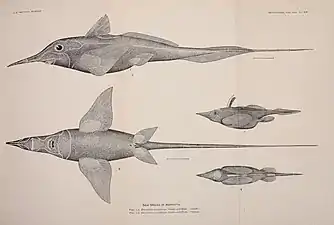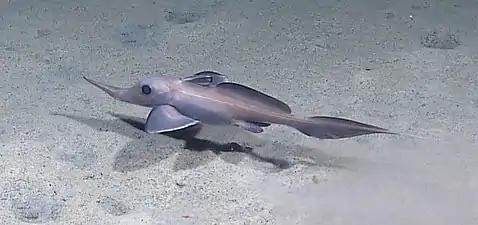Narrownose chimaera
The narrownose chimaera (Harriotta raleighana) is a longnose chimaera of the family Rhinochimaeridae,[2] the longnose chimaeras, consisting of eight species belonging three genera.[3] This species is found in temperate seas worldwide, at depths between 200 and 2,600 m.[2] Its length is between 1.0 and 1.5 m, including a long, tapering snout and a long, filamentous tail.[4]
| Narrownose chimaera | |
|---|---|
 | |
| Scientific classification | |
| Kingdom: | Animalia |
| Phylum: | Chordata |
| Class: | Chondrichthyes |
| Order: | Chimaeriformes |
| Family: | Rhinochimaeridae |
| Genus: | Harriotta |
| Species: | H. raleighana |
| Binomial name | |
| Harriotta raleighana Goode & T. H. Bean, 1895 | |
Taxonomy
This species was first described by George Brown Goode and Tarleton Hoffman Bean in 1895.[5] The genus Harriotta refers to Thomas Harriot and the species name references Sir Walter Raleigh.[6][7]
Description
Narrownose chimaeras have elongate rostra, slender tails, large pectoral and pelvic fins, large eyes, and two dorsal fins, the first being preceded by a spine.[6][7] They possess two pairs of non-replaceable tooth plates in the upper jaw and a one pair in the lower jaw.[8] Male H. raleighana are estimated to reach 62.8 cm and female 75.8 cm at maturity, respectively.[3]
Habitat
The narrownose chimaera is found off Nova Scotia and in much of the rest of the Atlantic Ocean,[9] and in parts of the Pacific Ocean to depths of 3100 metres.[6] Very little is known of their biology due to their deep water habitats.[8]
Reproduction
Longnose chimaeras are members of the class Chondrichthyes, diverging from their closest relatives (sharks, rays, and skates) approximately 400 million years ago.[10] Like many other Chondrichthyes, longnose chimaeras reproduce by laying eggs. Egg cases consist of a central chamber surrounded by a web-like structure.[8] Female longnose chimaeras lay a pair of eggs several times per season.[10]
Conservation status
The IUCN has classified this species as being of least concern.[1] In June 2018 the New Zealand Department of Conservation classified the narrownose chimaera as "Not Threatened" under the New Zealand Threat Classification System.[11]
 Illustration from paper giving the original description
Illustration from paper giving the original description Harriotta raleighana in the Gulf of Mexico in 2012
Harriotta raleighana in the Gulf of Mexico in 2012
References
| Wikimedia Commons has media related to narrownose chimaera. |
- Dagit, D.D.; Walls, R.H.L.; Buscher, E. (19 February 2015). "Harriotta raleighana". IUCN Red List of Threatened Species. 19 February 2015. Retrieved 20 January 2019.
- Torres, Armi G.; Sampang-Reyes, Arlene G. "Harriotta raleighana Goode & Bean, 1895 Pacific longnose chimaera". Fishbase. Retrieved 20 January 2019.
- Finucci, B.; Dunn, M. R.; Jones, E. G.; Anderson, J. (2017-02-01). "Reproductive biology of the two deep-sea chimaerids, longnose spookfish (Harriotta raleighana) and Pacific spookfish (Rhinochimaera pacifica)". Deep Sea Research Part I: Oceanographic Research Papers. 120: 76–87. doi:10.1016/j.dsr.2016.11.008. ISSN 0967-0637.
- Laura Gegel (2016-03-22). "Freaky winged fish with glowing green eyes mystifies fishermen". CBS News. Retrieved 2016-03-23.
- Goode, G. Brown; Bean, Tarleton H. (1895). "Scientific results of explorations by the U. S. Fish Commission steamer Albatross. No. XXX. On Harriotta, a new type of chimaeroid fish from the deeper waters of the northwestern Atlantic". Proceedings of the United States National Museum. 17: 471–473 – via Biodiversity Heritage Library.
- "FAMILY Details for Rhinochimaeridae - Longnose chimaeras". www.fishbase.org. Retrieved 2020-07-21.
- Goode, G.B.; Bean, T.H. (1895). "Scientific results of explorations by the US Fish Commission steamer Albatross. No. XXX. On Harriotta, a new type of chimaeroid fish from the deeper waters of the northwestern Atlantic" (PDF). Proceedings of the United States National Museum. 17: 471–473.
- Didier, Dominique A. "Phylogeny and classification of extant Holocephali." Biology of sharks and their relatives 4 (2004): 115-138.
- McMillan, Elizabeth (March 7, 2016). "Creepy deepwater fish surprises Nova Scotia fisherman". CBC News. Retrieved July 21, 2020.
- "Chimaera". The Shark Trust. Retrieved 2020-07-21.
- Duffy, Clinton A. J.; Francis, Malcolm; Dunn, M. R.; Finucci, Brit; Ford, Richard; Hitchmough, Rod; Rolfe, Jeremy (2018). Conservation status of New Zealand chondrichthyans (chimaeras, sharks and rays), 2016 (PDF). Wellington, New Zealand: Department of Conservation. p. 10. ISBN 9781988514628. OCLC 1042901090.
